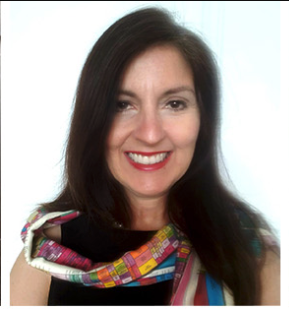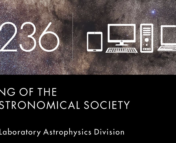In this series of posts, we sit down with a few of the keynote speakers of the 236th AAS meeting to learn more about them and their research. You can see a full schedule of their talks here, and read our other interviews here!
Disclaimer: This Astrobites piece reflects individual opinion, and does not represent any official views of NSF.

The radio frequency spectrum is a shared resource from engineers, to atmospheric scientists, to of course, radio astronomers. For example, ocean scientists measure ocean salinity in the same radio frequency band that radio astronomers use to measure the resonance of certain molecules in space, and you cannot tell one group of scientists they cannot carry out their science. The ever-changing knowledge, spanning multiple fields, required to think about these problems is certainly daunting. However, interdisciplinary and dynamic science is exactly where Professor Sandra Cruz-Pol, a Program Director with the National Science Foundation, thrives.
A radio frequency link between engineering and astronomy
Although Cruz-Pol loves stars and black holes, she did her degrees in electrical engineering; her PhD at Penn State was on using satellites to study the Earth and its atmosphere. Afterwards, she returned to the University of Puerto Rico at Mayagüez (UPRM; where she did her bachelor’s degree) where she taught for over twenty years. Due to her research background, using radio frequencies for remote sensing, she was a member of the U.S. National Academies Committee on Radio Frequencies (CORF) for nearly ten years. Through her time at CORF, she was introduced to astronomy applications of the radio frequency spectrum.
Radio astronomy enthusiasts might recall that until very recently, the Arecibo Observatory in Puerto Rico was the world’s largest single-aperture radio telescope; it certainly was the largest when Cruz-Pol was teaching at UPRM. As a result, many of her students worked at nearby facilities to design antennas, sensors, and mitigation techniques to avoid radio frequency interference. Such techniques are extraordinarily important for radio astronomers, as noise from these instruments might otherwise drown out or distort any data they acquire. She grew to appreciate just how linked engineering and astronomy were in the radio frequency spectrum, and after many years of working with CORF, she applied to rotate with the National Science Foundation (NSF) to be a Spectrum Manager for a year. The experience allowed her to learn, at both the national and international levels, how the radio frequency spectrum was managed to serve multiple science and engineering efforts.
Constantly learning in a dynamic world
Upon returning to UPRM, Cruz-Pol developed a course and wrote a book on radio frequency spectrum management, a topic important for both radio astronomers and engineers. After a while, she saw an opening at NSF again, this time regarding Engineering Research Centers. She was drawn to the interdisciplinary nature of these centers, and as she had previously participated in two of these centers as a researcher on weather radars, she decided she wanted to use her experience to give back to the scientific community and oversee these centers as a Program Director. As a Program Director, she intends to stay with the NSF.
With over 10 Engineering Research Centers across the U.S., each with a different topic and multiple associated universities, Cruz-Pol finds herself constantly learning about many different fields of research, from designing better solar panels for renewable energy to processing and using water from storms. Her current job is like a dream for her because she always likes to learn, and she gets to interact with many scientists and learn beyond her primary fields of expertise, which for her are electrical engineering, remote sensing, and solar power. Cruz-Pol says it was surprising to realize how often she had thought her specialized fields had nothing to do with a certain research center, only to suddenly spot a link. “And everything that you think you’re never going to be using again, all of a sudden you need and you’re using it in a different way,” Cruz-Pol says, smiling and animated. “So that’s really exciting for me because I would hate to be doing the same thing forever. I need change.”
“We belong in the room”
Cruz-Pol’s electrical engineering degrees meant she was the only woman in many classrooms. When asked what she would say to current students, she emphasized how important it is to not be afraid to speak up. For example, students should be proactive in looking for mentors and initiating discussions, even if one isn’t assigned to them. She also says to remember that “if you’re in the room, you belong in the room,” even if you don’t look like anyone else there. Recounting her experience as a professor at UPRM, Cruz-Pol recalls that many of her students — especially women — were overly harsh on themselves in thinking they weren’t prepared to conduct research. She says it is important to “be open to opportunities, don’t be afraid to ask your professors for research opportunities because they really enrich your experience,” and especially for women, to also “believe more in ourselves.”
Being a woman in science and engineering has many challenges, and Cruz-Pol acknowledges the added burden she took on early in her career to make women more visible in her department. Although it was a lot of work, she knew it was important to be present, as well as to support her women colleagues; Cruz-Pol notes that although there is often a stereotype of there being only one woman in a room full of men, the reality is there is room for many women in any environment. Ultimately, she remains optimistic that gender equality is better now that it has been, and little by little, we must keep increasing the percentage of women in STEM. From the ever-evolving demands on the radio frequency spectrum to diversity improvements, Cruz-Pol is enthusiastic about the future — and how we can work to improve it.
To learn more about Prof. Cruz-Pol’s work, tune in (pun intended) to her talk, An Introduction to the RF Spectrum Regulations, jointly held with Prof. James Lowenthal’s talk at 12:40 pm EDT on Tuesday, June 2nd at #AAS236.

